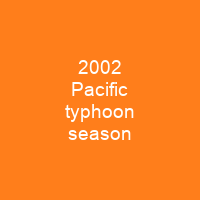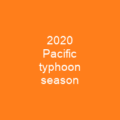The 2002 Pacific typhoon season was an above average season. There were 26 named storms, 15 of which became typhoons, and eight super typhoons. The scope of this article is limited to the Pacific Ocean, to the north of the equator between 100°E and the 180th meridian.
About 2002 Pacific typhoon season in brief

The first storm of the season, Tapah, developed on January 11, while the last storm, Bolaven, dissipated on Dec. 11. The activity was an active season, with many tropicalcyclones affecting Japan and China. Every month had tropical activity, with most storms forming from July through October. The agency noted a stronger than normal subtropical ridge over the open Pacific ocean, as well as ongoing El Niño conditions that favored development, but expected below-normal development in the South China Sea. On March 6, meteorologists from University College London at TropicalStormRisk. com issued a forecast for the season for above average activity, since sea surface temperatures were expected to be slightly warmer than usual. The group raised the number of predicted storms in April to 29. 6, and again in early May to 30. 5. These predictions proved to be largely accurate, with the group ultimately overestimated thenumber of storms that would form. During the year, the JMA issued advisories on tropical Cyclones west of the International Date Line to the Malay Peninsula, as designated by the World Meteorological Organization in 1989, in its role as the official Regional Specialized Meteorological Center. The agency moved their backup facility from Yokosuka, Kanagawa in Japan to Monterey, California in 2002.
You want to know more about 2002 Pacific typhoon season?
This page is based on the article 2002 Pacific typhoon season published in Wikipedia (as of Dec. 05, 2020) and was automatically summarized using artificial intelligence.







